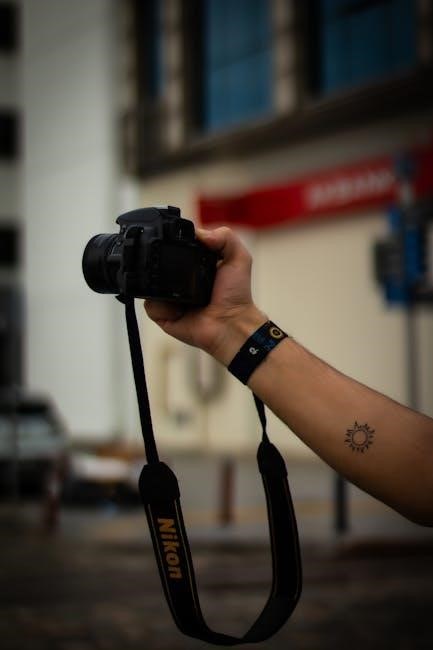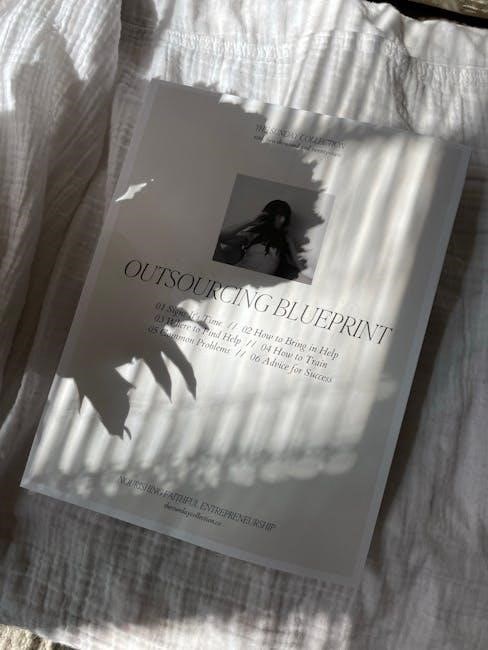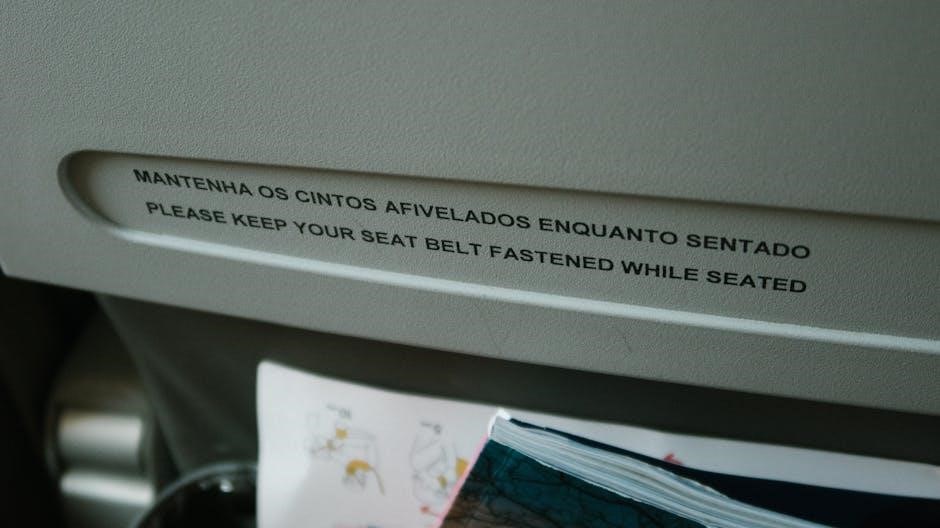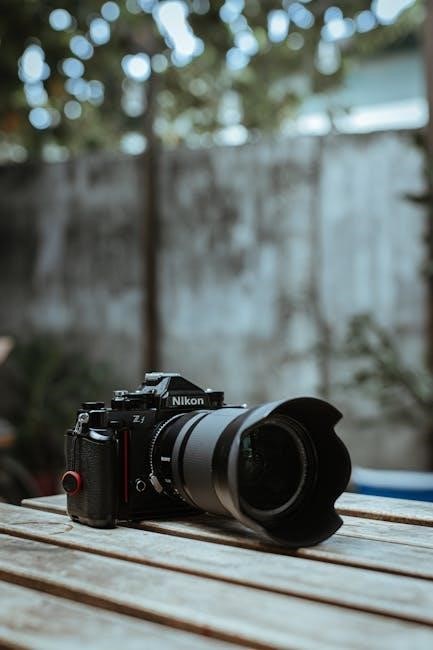
The Nikon D810 instruction manual provides comprehensive guidance on operating the camera‚ covering features like the 36․3MP sensor‚ ISO range‚ and advanced autofocus system․
Overview of the Nikon D810 and Its Manual
The Nikon D810 manual provides detailed guidance on the camera’s features‚ including its 36․3MP CMOS sensor‚ ISO range up to 51200‚ and advanced autofocus system․ The manual is available online as a PDF‚ offering step-by-step instructions for optimal camera use․ It covers essential functions like shooting modes‚ menu navigation‚ and troubleshooting․ Additionally‚ the manual highlights new features such as the i-button‚ expanded bracketing options‚ and the electronic first curtain shutter․ Users can download the manual from Nikon’s official website or third-party resources‚ ensuring access to the latest updates and authentic information․

Key Features of the Nikon D810
The Nikon D810 features a 36․3MP CMOS sensor‚ ISO range up to 51200‚ 51-point autofocus‚ and 1080p video capabilities‚ ensuring exceptional image quality and versatility․
36․3 Megapixel CMOS Sensor and Image Resolution
The Nikon D810 is equipped with a 36․3-megapixel full-frame CMOS sensor‚ delivering exceptional image detail and clarity․ The sensor captures images at a maximum resolution of 7360 x 4912 pixels‚ ideal for professional photography․ It lacks an optical low-pass filter‚ enhancing sharpness and texture․ The camera supports various image formats‚ including NEF (RAW)‚ TIFF‚ and JPEG‚ as well as RAW S for smaller file sizes․ With a dynamic range of up to 14 stops‚ the D810 excels in capturing subtle tonal variations‚ making it a powerful tool for landscape‚ portrait‚ and studio photography․
ISO Range and Noise Performance
The Nikon D810 offers an ISO range of 64 to 12‚800‚ expandable to 32 (LO-1) and 51‚200 (HI-1)‚ ensuring versatility in various lighting conditions; With enhanced noise reduction technology‚ the D810 delivers clean images even at high ISO settings․ The camera’s EXPEED 4 image processor optimizes noise performance‚ reducing grain and preserving detail․ This makes the D810 suitable for low-light environments‚ such as indoor events or astrophotography‚ while maintaining high image quality across the entire ISO spectrum․
Advanced Autofocus System
The Nikon D810 features a 51-point autofocus system with enhanced tracking capabilities‚ utilizing the Advanced Scene Recognition System․ This system‚ combined with a 91K-pixel RGB sensor‚ provides precise subject detection and focus accuracy․ The AF system supports 11 cross-type sensors‚ ensuring sharp focus even in challenging lighting conditions․ With modes like Single AF‚ Continuous AF‚ and 3D Tracking‚ the D810 excels in capturing dynamic subjects․ Additionally‚ the camera offers customizable AF settings‚ allowing users to tailor focus behavior to their specific needs for optimal results in both stills and video․
Video Capabilities and Features
The Nikon D810 supports high-quality video recording in Full HD (1080p) at frame rates up to 60p‚ delivering smooth motion and detailed imagery․ It offers manual controls for exposure‚ ISO‚ and audio levels‚ allowing filmmakers to customize settings for professional-grade results․ The camera also features zebra stripes for overexposure control and a built-in stereo microphone for improved audio capture․ Additionally‚ the D810 supports external recording devices via HDMI and includes options for simultaneous internal and external recording‚ making it a versatile tool for both amateur and professional videographers․

Getting Started with the Nikon D810
Unbox and set up your Nikon D810 by charging the battery‚ mounting a lens‚ and navigating basic settings for initial operation and customization․
Unboxing and Initial Setup
When unboxing the Nikon D810‚ ensure all accessories are included‚ such as the camera body‚ battery‚ charger‚ and strap․ Begin by charging the battery fully before first use․ Mount a compatible lens‚ ensuring it clicks securely into place․ Insert a memory card‚ preferably SD or CF‚ and format it in-camera for optimal performance․ Power on the camera and navigate through the initial setup menu to set language‚ time zone‚ and date․ Familiarize yourself with the camera’s layout and basic controls to prepare for your first shoot․
Understanding the Camera Layout and Controls
Familiarizing yourself with the Nikon D810’s layout is essential for efficient operation․ The mode dial on top allows quick selection of shooting modes‚ while the release mode dial offers options like single or continuous shooting․ The ‘i’ button provides rapid access to key settings․ The LCD screen on the back serves for menu navigation‚ image review‚ and live view․ Dedicated buttons for ISO‚ white balance‚ and autofocus modes streamline adjustments․ The ergonomic grip and intuitive control placement enhance handling․ Study the manual to master these controls and customize settings for personalized shooting experiences․

Basic Camera Operation
The Nikon D810’s basic operation involves mastering shooting modes‚ focusing techniques‚ and ISO settings‚ ensuring smooth navigation and optimal customization for photographers of all levels․
Mode Dial and Shooting Modes
The mode dial on the Nikon D810 offers various shooting modes‚ including Program Auto‚ Aperture Priority‚ Shutter Priority‚ and Manual Mode‚ allowing photographers to customize their shooting experience․ Scene Modes provide optimized settings for specific genres‚ while U1 and U2 let users save custom configurations․ The manual also covers ISO sensitivity and focusing techniques‚ ensuring users can adapt to different lighting conditions and subjects․ This flexibility makes the D810 adaptable for diverse photography needs‚ from casual to professional use․
Using the Viewfinder and LCD Screen
The Nikon D810 features a 3․2-inch‚ 1‚229k-dot LCD screen for precise image review and menu navigation․ The optical viewfinder offers 100% frame coverage‚ ensuring accurate composition․ The LCD supports touch functionality for adjusting settings and focusing․ The viewfinder provides critical shooting information‚ including exposure data and focus points․ The manual explains how to customize the viewfinder and LCD display‚ such as enabling the electronic level or grid display‚ to enhance shooting efficiency and image review․ These tools help photographers achieve better focus‚ exposure‚ and composition in various shooting scenarios․

The Menu System Explained
The Nikon D810’s menu system provides a comprehensive guide to adjusting settings‚ ensuring optimal camera performance․ It covers shooting‚ playback‚ and customization options for enhanced control․
Navigating the Custom Settings Menu
The Custom Settings menu on the Nikon D810 allows users to tailor camera behavior to their preferences․ It includes options like autofocus modes‚ metering systems‚ and bracketing controls․ Users can access this menu by navigating through the camera’s LCD screen‚ where each custom setting is categorized for easy adjustment․ This feature is particularly useful for photographers seeking precise control over their shooting experience‚ ensuring that the camera aligns perfectly with their creative vision and technical requirements․
Shooting Menu Options
The Shooting Menu on the Nikon D810 offers a wide range of options to customize your photography experience․ Key settings include Image Quality‚ White Balance‚ and ISO Sensitivity‚ allowing precise control over image capture․ The menu also features options for Active D-Lighting‚ HDR‚ and Long Exposure Noise Reduction‚ helping to enhance dynamic range and reduce noise in various shooting conditions․ Users can also configure settings for intervals‚ time-lapse photography‚ and focus modes‚ ensuring flexibility for diverse photographic needs․ These options enable photographers to tailor the camera’s performance to their creative vision and technical requirements․
Playback and Retouch Menu Features
The Playback menu allows users to review and manage images on the LCD screen‚ with options for zooming‚ deleting‚ and protecting files․ The Retouch menu offers in-camera editing tools‚ enabling adjustments such as D-Lighting‚ Red-Eye correction‚ and image trimming․ Additional features include converting RAW files to JPEG‚ applying filters‚ and creating miniatures․ These tools provide convenience for making quick edits without transferring images to a computer‚ enhancing workflow efficiency for photographers․ The menu also supports side-by-side image comparison‚ aiding in evaluating edits and ensuring optimal results․

Advanced Shooting Techniques
Explore Focus Shift Shooting for depth control and Silent Shooting to reduce noise․ These techniques enhance creativity and precision in various photography scenarios‚ optimizing image quality and capture․
Bracketing and Interval Shooting
The Nikon D810 offers advanced bracketing and interval shooting modes‚ allowing photographers to capture a range of exposures for HDR or time-lapse photography․ Bracketing supports up to 9 frames with 2 or 3 EV stops‚ while interval shooting enables images at set intervals for dynamic sequences․ These features are complemented by the electronic first curtain shutter‚ reducing vibrations for sharper results․ The manual also explains how to use split-screen zoom in Live View during bracketing for precise focus alignment‚ ensuring optimal results in challenging lighting conditions and complex compositions․
Using the Time-Lapse Photography Feature
The Nikon D810’s time-lapse photography feature allows users to capture sequences of images at set intervals‚ creating stunning dynamic videos․ The manual explains how to configure intervals from 1 second to 8 hours and the number of shots․ This feature is ideal for documenting events like sunsets or star movements․ Additionally‚ the camera supports exposure smoothing to maintain consistent lighting between frames‚ enhancing the final output quality․ With detailed instructions‚ photographers can easily create professional-grade time-lapse sequences‚ leveraging the D810’s advanced capabilities for impressive visual storytelling․

Troubleshooting Common Issues
The Nikon D810 manual helps resolve common issues like error messages and technical glitches․ It provides solutions and troubleshooting guides to ensure optimal camera performance; Refer to the manual or contact Nikon support for assistance․
Resolving Error Messages
Understanding and resolving error messages is crucial for optimal Nikon D810 performance․ The manual provides detailed explanations for common error codes‚ such as “ERR” or memory card issues․ Solutions include turning the camera off and on‚ formatting the memory card‚ or updating firmware․ Specific error codes often relate to lens or sensor malfunctions․ The manual guides users through troubleshooting steps to identify and fix problems․ For persistent issues‚ contacting Nikon support or visiting a service center is recommended․ Regular firmware updates can also prevent errors and ensure smooth operation․
Common Problems and Solutions
Common issues with the Nikon D810 include memory card errors‚ lens compatibility problems‚ and autofocus malfunctions․ For memory card errors‚ formatting the card in-camera often resolves the issue․ Lens issues may require updating the firmware or cleaning the contacts․ Autofocus problems can be addressed by recalibrating the lens or using the AF Fine Tune feature․ The manual also advises checking for firmware updates to resolve bugs and improve performance․ Regular camera maintenance‚ such as cleaning the sensor and mirror‚ can prevent many issues․ Always refer to the manual for specific troubleshooting steps to ensure optimal functionality․

Accessories and Compatibility
The Nikon D810 supports a wide range of accessories‚ including compatible lenses‚ external flashes‚ and remote controls‚ enhancing its versatility for various photography needs․
Compatible Lenses and Mounts
The Nikon D810 is compatible with a wide range of Nikon F-mount lenses‚ ensuring versatility for photographers․ It supports both FX and DX-format lenses‚ with automatic cropping for DX lenses․ The camera is fully compatible with AF-S‚ AF-D‚ and AF-I lenses‚ as well as manual-focus AI and AI-S lenses․ Teleconverters like the TC-14E III and TC-20E III can extend focal length․ The D810 also supports lens accessories like filters and hoods‚ enhancing creativity and functionality․ This compatibility ensures users can leverage their existing lens collection for optimal performance and flexibility․
Recommended Accessories for the D810
The Nikon D810 can be enhanced with various accessories to improve functionality and comfort․ The MB-D12 battery grip is recommended for extended shooting sessions and better ergonomics․ High-speed memory cards‚ such as U3-rated SD cards‚ are essential for capturing high-resolution images and video․ External flash units like the SB-910 can expand lighting capabilities․ The ME-1 stereo microphone is ideal for high-quality audio recording during video shooting․ Additionally‚ the EH-5b AC adapter is useful for studio or indoor photography․ These accessories help maximize the D810’s potential for professional and creative photography needs․

Downloading and Using the Manual
The Nikon D810 instruction manual can be downloaded from Nikon’s official website or third-party resources like ManualsLib․ Ensure authenticity by using trusted sources․ The manual is available in PDF format‚ making it easy to access and reference offline․ Additionally‚ Nikon offers the Manual Viewer 2 app for mobile devices‚ allowing users to download and view the manual conveniently․ This resource provides detailed instructions on camera operation‚ settings‚ and troubleshooting‚ ensuring users can fully utilize their D810’s capabilities․
Official Sources for the Nikon D810 Manual
The official Nikon D810 manual can be downloaded directly from Nikon’s website․ Visit the Nikon support page‚ where you’ll find a dedicated section for the D810․ The manual is available in PDF format‚ ensuring easy access and offline use․ Additionally‚ Nikon provides the Manual Viewer 2 app for iOS and Android devices‚ allowing users to download and view the manual on their smartphones or tablets․ Always use official sources to ensure authenticity and access the most up-to-date version of the manual․
Third-Party Resources and Guides
Beyond the official manual‚ third-party resources offer additional insights and tips for mastering the Nikon D810․ Websites like ManualsNet provide free PDF downloads of the manual‚ while books like Mastering the Nikon D810 by Darrell Young offer in-depth tutorials․ Online forums and communities‚ such as those dedicated to Nikon D8xx series‚ share user experiences and troubleshooting advice․ These resources complement the official guide‚ helping users explore advanced techniques and resolve common issues effectively․ They are valuable for both beginners and experienced photographers seeking to optimize their camera’s performance․

Additional Resources and Support
Explore the Nikon Manual Viewer 2 app for offline access to manuals and online forums for troubleshooting and expert tips on maximizing your D810’s potential․
Online Communities and Forums
Active online communities and forums dedicated to the Nikon D810 provide valuable resources‚ troubleshooting tips‚ and expert advice․ Platforms like Facebook groups‚ Reddit forums‚ and specialized photography communities offer spaces to discuss camera settings‚ share techniques‚ and resolve common issues․ Many users also recommend accessing the Nikon Manual Viewer 2 app for offline manual access․ Additionally‚ Nikon’s official website and third-party sites like ManualsNet provide downloadable PDF manuals and guides․ These resources ensure comprehensive support for mastering the D810’s features and resolving technical queries effectively․
Recommended Reading and Tutorials
Recommended reading and tutorials for mastering the Nikon D810 include Darrell Young’s Mastering the Nikon D810‚ offering in-depth insights‚ and John Greengo’s guide‚ providing expert-based information․ The official manual covers features like the i-button and electronic first curtain shutter․ Nikon’s website and third-party sites like ManualsNet offer downloadable resources․ The Nikon Manual Viewer 2 app allows offline access․ These resources enhance the learning experience‚ helping users optimize their camera’s capabilities and unlock its full potential effectively for both beginners and advanced photographers alike․